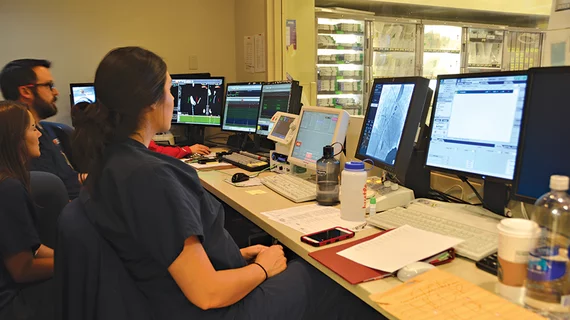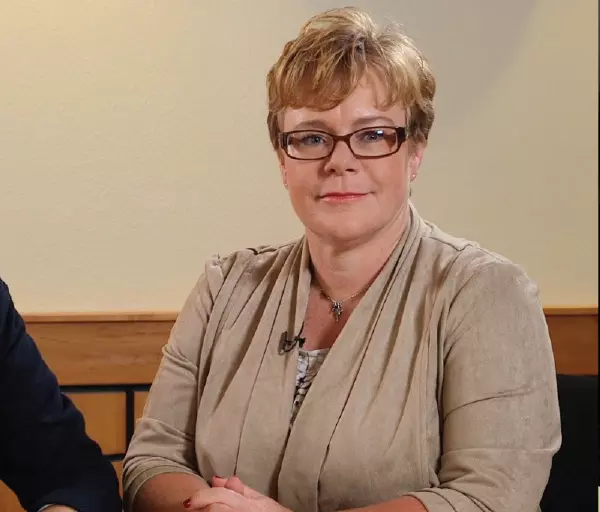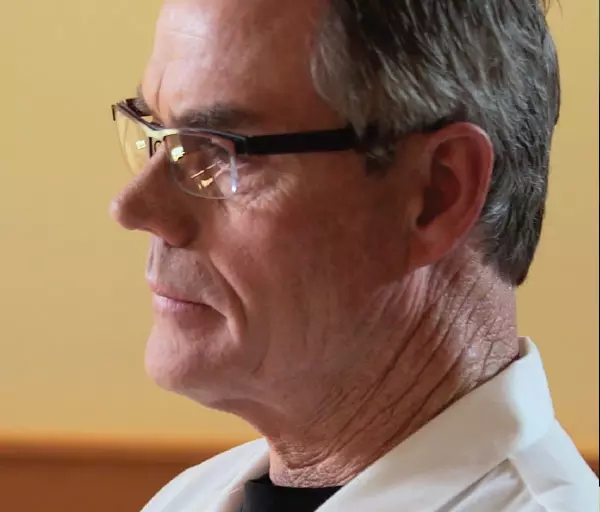From the Ground Up: Building a Better Interventional Program — Strategies for Cardiology Service Line Directors
Strategies for Cardiology Service Line Directors
Topping the list of must haves when rolling out a new complex PCI program are a solid mission to offer leading-edge technology, top-down administrative support, physician and nursing leadership, a quest for quality, and a well-oiled team. And in the case of the 194-bed San Juan Regional Medical Center in Farmington, N. M., independence was on the list too as this rural hospital must be self-reliant in caring for emergent patients. Abiomed’s Impella 2.5 miniature temporary heart pump is key to helping them help patients. Their innate confidence fueled by ongoing training and protocols has served the heart team well, and their advice is solid for care providers in urban, suburban, and rural settings seeking to offer quality care while maintaining a healthy bottom line.
Hear more from the team at San Juan Regional Medical Center, watch Episode 1: From the Ground Up: Building a Better Interventional Program from the series, Strategies for Cardiology Service Line Directors.
San Juan Regional Medical Center launched its dedicated cardiac care unit in 2006. They started out slowly and methodically, training staff, building protocols, solidifying their team, and watching their data, says Barbara Charles, RN, BSN, the Cardiology Service Line Director. Six patient rooms grew to 24 when the hospital opened a new wing in 2010 and became a primary PCI hospital and ST-Elevation Myocardial Infarction (STEMI) receiving center. They currently staff 16 beds. To expand their offerings further, they brought on Impella in 2011. In 2015, they treated 65 STEMI patients and placed 29 Impella heart pumps.
The vision to start an interventional cardiology program without surgical backup was the brainchild of a San Juan Regional administrator a dozen years ago. “We needed to expand what we could do here to avoid lengthy transfers and poor outcomes,” recalls Charles who at the time was manager of the Cardiology Unit, Cardiac Cath Lab and Cardiac Rehab. They hired a consulting firm to analyze volume and sustainability to see if a Protected PCI program was feasible and explored the risks and benefits of such a program without surgical backup. They then sought help to create a plan and connect them with doctors who could make it happen—and gave the doctors and heart team a blank slate to dictate priorities.
“It was a big leap to go from not performing PCI to performing PCI without surgical backup,” Charles recalls. “That kicked off in the fall of 2007 when we formed the heart center as it is known today.”
Charles Wilkins, MD, was named chief of cardiology and together with his partner, Luther Weathers, MD, both transplants from Texas, they packed their bags and vast knowledge base and leadership skills and headed north to Farmington.
What appealed to Wilkins most about the move? “The willingness of administration to work with us to allow us to build a program from the ground up and do it the right way.”
Building from the ground up meant setting up a program that was quality driven and utilized guideline-based best practices. One of Wilkins’ stipulations was participation in national registries to prove outcomes were satisfactory. He told administration early on that the PCI program wasn’t going to be a rainmaker or a profit center, only doing the cases they needed to. “They said ‘that's fine,’” he recalls. “It's a small town so if you have bad outcomes, that will get around. Today, our volumes are growing, we participate in four national registries, our data show excellent outcomes, and we’re an accredited chest pain center.”
Back in 2011, with both Impella and the interventional program both at a young age, the heart team knew it needed to become independent quickly, “especially if we were going to utilize Impella for the shock patient,” Charles recalls. “I'm not going to be able to call Abiomed and get a rep here in 5 minutes, so I think because we are so used to that, it's just how we approach things. The physician relationship with the team both in the cath lab and the cardiology unit was already strong, with lots of trust, and good communication. The cardiologists had already been engaged in staff training and education and growing the team before we embarked upon Impella, so it just perpetuated.”
To become independent, they needed to train and retrain. Training physicians and cath lab staff on Impella was priority one, beginning with the team completing a series of higher-risk PCI cases. The team did three or four elective higher-risk PCIs so the lab gained fluency in procedures and physicians gained experience with the device. “We would do routine drills,” Wilkins recalls. “Here's a patient on the table, set it up. That way everybody got experience. We also did the same with hands-on nursing training in bringing the patient to the floor and supporting him or her with a self-built protocol and flowsheet and simulation training.” Then they segued into using Impella for primary PCI and shock patients.
Since then, they have increased their percentage of high-risk procedures, says Cath Lab Supervisor Tammie Herrera, RT(R), RCIS. “We're able to take care of patients who we wouldn't have taken care of before, due to the high risk. We can place an Impella, we can do high-risk lesions, and do bifurcation lesions that we wouldn't have done prior to the Impella being here.”
An interventional program in a small community surprises some folks. “Folks are surprised we have an advanced primary PCI program, and that we use advanced technologies like Impella heart pumps as well,” Charles says. “We serve not only Farmington, but really there are hundreds of miles between us and the nearest tertiary hospital.”
That remoteness in fact has helped to empower the heart team. “It is what creates the ability and confidence of the staff,” Wilkins notes. The team is self-sufficient, from EMTs communicating from field to hospital, in the ER, cath lab, and post-procedure nursing support. Teamwork is central to success.
Charles adds the exclamation point. “If we can do it here, anyone can do it.”
Helping shock patients
Impella also is helping to save lives in the 5 to 8 percent of patients who walk or roll through the ER in cardiogenic shock with an AMI, thanks to its ability to unload the left ventricle and allow physicians to perform interventions in a very relaxed manner, according to Wilkins.
With an average STEMI count per month of about six to eight, the San Juan Regional Medical Center team is putting in about two Impella heart pumps a month in shock patients. Some of that volume is attributed to delayed presentation and long transport times. “Particularly in shock patients, we are really amazed with Impella and what it does,” Charles adds. “It's like putting this tool in our tool kit to impact outcomes for patients and still keep them here at home.”
With the Impella program keeping patients closer to home, revenue stays local too, notes Cardiology Educator Rebekah French, RN, BSN, RCIS. “It allows us to care for our patients here in Farmington, instead of having to fly them to bigger universities or bigger areas like Albuquerque and Denver,” she says, “especially for those cardiogenic shock patients who don't have the time to fly somewhere for intervention.”
This spring, the FDA expanded the options for patients when it gave a PMA (premarket approval) to Abiomed’s family of Impella left-heart pumps for treating AMI patients with cardiogenic shock.
The expanded approval—which comes just a year after the FDA’s greenlighting of Impella 2.5 for high-risk PCI patients—allows the use of Impella devices to help stabilize the shock patient’s hemodynamics, unload the left ventricle, perfuse the end organs, and rest the heart enough to, ideally, recover full function.
The FDA’s updated labeling showing the Impella family as the first and only percutaneous temporary ventricular support devices deemed safe and effective for the cardiogenic shock indication states: The Impella 2.5, Impella CP, Impella 5.0, and Impella LD catheters, in conjunction with the Automated Impella Controller console, are intended for short-term use (<4 days for the Impella 2.5 and Impella CP and <6 days for the Impella 5.0 and Impella LD) and indicated for the treatment of ongoing cardiogenic shock that occurs immediately (<48 hours) following acute myocardial infarction (AMI) or open heart surgery as a result of isolated left ventricular failure that is not responsive to optimal medical management and conventional treatment measures with or without an intra-aortic balloon pump. The intent of the Impella system therapy is to reduce ventricular work and to provide the circulatory support necessary to allow heart recovery and early assessment of residual myocardial function.
Knocking down the challenges, training first
Training has been a central strength of San Juan Regional Medical Center’s program, including physicians, nurses, cath lab, ICU, and Air Care staff. From the beginning, the team created protocols for physicians and flowsheets for nursing, modifying them over time as experience changed. As Charles notes, “There are a lot of details in successful management of the Impella. Asking the physician after every case to remember to write all them down is not effective. The development of a written protocol was essential. Following it every single time can really help hardwire the detailed processes for the nursing staff.”
The physician writes “Impella per protocol” and nursing knows exactly what to do, even if it has been a little while since they have cared for a patient treated with the Impella system. They created an hourly flowsheet to make sure the protocol was followed and nurses were documenting well. This also ensured greater quality of care in the transition from cath lab to cardiology floor, or ICU in the case of an intubated patient. An effective transition starts when the cath lab notifies the floor to prepare for a patient and moves to a verbal report at the bedside with the cath lab and nursing. When needed, an echo is done to be sure of proper positioning of the Impella device. Nursing transitions from 2:1 to 3:1 once the patient stabilizes. New nurses, even graduate nurses, are brought up to speed more quickly via orientation and training with plenty of hands-on experience and mentoring.
New nurses are trained while veterans are retrained periodically, always staying current under the guidance of French. She also handles training for the Cardiology Unit and Cardiac Cath Lab, and partners with the leadership in ICU and Air Care to ensure their teams are included in training. Simulation training is an important component of training, offering hands on experience that incorporates patient case studies. “Hands on helps everyone to better handle any patient situation they are in,” she says.
Motivation to train is never an issue because staff cares about outcomes, Charles says. “They want to see patients get better and they understand training is central to that.” All training is mandatory and paid, with administration’s strong support. The way they see it, the cost of not training could hurt outcomes and revenue and require patients to travel out of their community for care.
Quality leads the way
The formula at San Juan Regional Medical Center is working. Outcomes are excellent, the data prove it. And the PCI and Impella programs are financially healthy, too. That starts with the coding worksheet in the Impella box. “We require the physicians to complete that form on every patient treated with Impella before the patient leaves the lab. That form gets scanned to a PDF and sent to a mail group.” As Charles points out, the number one priority before a patient is rolling out of the cath lab is that he or she has inpatient status. “You have to have that hardwired into your cath lab team. That's where the ownership needs to happen in partnership with the physician.”
Next the coding team takes over. “Whether they're internal or external or a little bit of both, if they don't understand those words, it's not going to code out right, so our head of coding makes sure that she is specifically touching those accounts, to be sure that it coded out to an appropriate DRG,” she says. “They are also reviewed monthly and quarterly. A final draft format is given high-level review by a multidisciplinary chest pain team, so there is no need for extra full-time employees tracking data.”
While the bottom line is top of mind, it is quality that will get you there. As Charles says, “If you chase quality, the finances will follow. If we have great quality outcomes, and then we tweak and work on the details, whether it's the documentation or coding or training, that's going to help all of that. Your eye should always be on the patient.”
Wilkins sees it the same way. “You do quality work, you have good outcomes,” he says. “Everything will take care of itself in the end. You cannot be looking at the profit margin with every case because you're not going to make money on every case. It's not why we're here.”
Impella also brings him a sense of professional satisfaction. “The treatment for myocardial infarction when I started medical school was bed rest, with a 30 percent mortality. That's how far we've come.”



